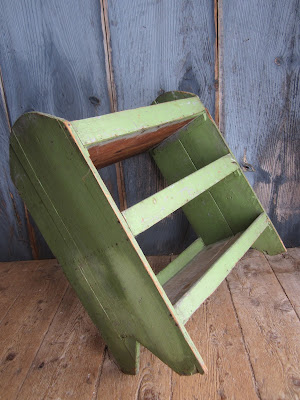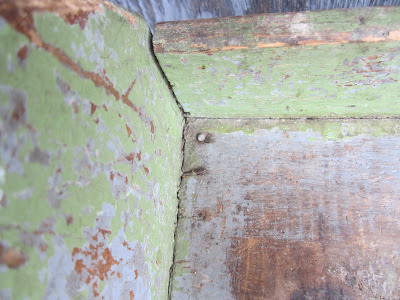The Silver Twin's ...Place...
In New England Decorative Art
Part Ten
"Triple Jump"
Returning to the ‘frontier’ and
updating the ‘hiatus’ (Part Nine [A]) of the Silver Twin’s Place... I briskly
summarize:
Take
down (shed)
Collapse
(barn) (“dangerous”)
Closed
up house
Burns
flat.
No
real surprise there: “Awful
OLD
place
It
WAS”.
And
add in the fifty years of “closed up” after the “LAST PEOPLE TO LIVE THERE”
(the actual “Silver Twins”). The
“moved them out”. The “cleaned it
out”. The “got in again” (Part
Nine [A])... and: All the pieces
fit. Right?
The
old wooden sap spiles (Part Two)... et al... I purloined, myself, the ‘best I
could’. And I figured antiquers
had been knocking on that door for
SEVENTY-FIVE
YEARS (starting 1920’s)
For
sure and that probably having a nineteenth century ‘dealer’ knock on the door
Too.
Yep...: The place
Had
been ‘gone through’
Before
it burned
“Flat”:
“RACCOONS
BEEN LIVING IN THE ATTIC ONE OF ‘EM COME OUT ON FIRE”. I wasn’t even around for it (the
‘burned flat’). It had been a
solid decade since I even ‘last drove by’...
Up
over Silver Hill.
I
figure.
Before
I ended my ‘special events’ visits I had brought forth my ‘qualified quandary’
of the Silver Twins hoard of old New England decorative arts and have written
out how that ‘carries’ using their old broken farm baskets as a specimen
example of that aesthetic. And the
consideration (‘qualified quandary’) of ‘setting’. Too. Then I
noted my interest of ...did they (the Silver Twin’s Place) have what I called a
“stoic old New England crude primitive design jewel(s)” ‘in there’ that I
found” (end Part Nine [B]).
Before
the place burned flat.
This
last (‘burned flat’) vanquishes the second consideration of the aesthetic of
‘qualified quandary’ of ‘setting’.
In case your trying to keep track.
It’s just the “grown up” there now. No structures and one would ‘never know’d they’d been one’
(a Silver Twin’s Place). Or that
there ever could have been a consideration of ‘qualified quandary’ of ‘setting’. Too. JUST SOME “nice” “wildflowers” when “you drive by”. So now that I have set up the cracker
barrel with the checkerboard on top, let me do a couple of triple jumps of the
aesthetic of the Silver Twin’s ...Place... in New England Decorative Art... and
then get out (end this missive).
Leaving
you to drive by the wildflowers of all this
On
your own.
I
cannot walk into our kitchen without noticing a ‘crude’ ‘primitive’ “shelf
unit” set up against the “(black) soapstone topped” “island” in the center of
the kitchen. “Flushed” up against the island in an appropriately worn old “puke”
or “baby shit”*** green paint is a light
as a feather ‘tombstone ends’ shelved storage unit handmade from mid nineteenth
century packing crate (thin ‘finished’) boards. This unit has three ‘older’ paint ‘colors’ under the ‘green’
and retains the ‘never painted’ inner shelf boards that were ‘always covered’
(with loose paper?). It measure 30
inches wide, 34 inches tall, 14 inches deep and ‘come out of’ (I bought it
from) the Silver Twin’s kitchen. It was ‘covered’ (shelves filled full) with
‘kitchen stuff’ when I spied it and bought it... all... as a unit and ‘got it
out of there’. My wife took it off
of me when I got home.
She
wiped it down.
Put
it “there”
Its
been there ever since.
She
likes it. I like it.
It’s
got some of her cooking crud on it.
Nothing overloading it.
That’s
not what this is about.
It’s
about the “a stoic old New England crude primitive design jewel(s) ‘in there’
that I found”.
From
a perspective of (and only of) old New England design this (shelf unit)
...form... stands here as a singular fabrication of actually
difficult-to-create (especially considering the light thin boards)... function
intentional... balanced in size and weight... slightly embellished (tombstone
top ends) made ON THE (Silver Twin’s) PLACE... and drawing from no other
inspirational directives other than ...old Maine shed door barn yard design AND
a few “from the wife” expressions of (design). She “I need” and/or “want”. There it is; designed, made, used. No one... anywhere else... ever. Except, of course, it’s my wife’s NOW. After “it” (the homestead) “burned”
flat. Let us not make too much of
this for it is
ONLY
WHAT IT IS...
But
that ‘what it is’ IS a ‘pure strain’ of ... old New England Decorative Art
(design).
Do
I have a source of evidence respecting and supporting this ‘pure strain’? Yes. I return to the Concord Museum (Parts Seven and Eight). I have used it twice already and so
return to the same museum and the same reference book for their collection to
find... a very special stoic old New England crude primitive design jewel.
Collection
catalog number “15” “Desk” shows a “one of the humblest in the collection”
(from a design perspective). It is
also a “most historically significant” (heritage) too. The latter is that the desk, pencil
dated 1838, was one of a set (it is believed) of identical desks constructed
and... painted green... that were locally fabricated for the Thoreau brothers
for their school of that year (1838).
The school failed but... this single desk... survived dispersion by
being retained by Henry David. He
took it to the hut at Walden Pond and there wrote, including the ‘journal’ of
WALDEN, on it. When he left
Walden, the desk left too and reappears at the head of the stairs in Emerson’s
home and was there still used for writing by Henry David. Eventually, through Thoreau’s sister,
the desk passes to the Museum. Its
heritage is impeccable?
It’s
design is... nothing. True... it
is but a green painted ‘stick’ desk; a form of that form (stick
furniture). But... divinely merged
with Thoreau at Walden, particularly noting the philosophic heritage
(principals) of Walden... the desk and it’s design... ARE consistent with a
Walden – Transcendental vision... and
That
vision
Points
at... too... the Silver Twin’s ...Place... and its decorative arts. Is not the essence of Walden written on
this desk the very celebration of the Silver Twin’s New England homestead’s
simple ‘self reliance’? Its (the
Silver Twin’s Place) hand carved wooden sap spiles... are an intellectual
vision? I certainly do not miss
the connections and... hold them to be true. It is so true to I (us; my wife and I) that it (this
intellectual vision) is in our kitchen... too. We seek it, find it, save it and protect it. Here, though, the Twin’s kitchen shelf
unit, fabricated as a ‘pure strain’, becomes a splendid third ‘triple jump’ of
this aesthetic when wedded to Thoreau and his desk.
A
step higher?
Although
that comparative unit works fine for buttressing the ‘stoic old New England
crude primitive design jewel’ object I have been harping about... so it may
become the ‘THE’ “...place...” of New England Decorative Art contributed by the
Silver Twin’s homestead...
I do
Personally
Like
my ‘that’; the “MINE.... THAT”... a little bit more ‘hardball’. That means, principally, I like it
‘older’ (Colonial settlement era) and crafted ...tougher... meaning a little
more past a ‘your not gonna just FIND THAT’. Object... so...:
What I bring up as ...triple jump... support and evidence for this ‘step
higher’ is... an old
Barn
door. Weather beaten old relic
abandoned moved tossed pitched nailed up dragged here and there used again and
again but always the managing to be the same: A Barn Door.
This one... “Jesus I don’t know WHERE it came from on that property” but
it was
STILL
THERE and... I said “Oh wow” right away and... got it out of there. It wasn’t attached to anything when I
found it but it had definitely been ‘put away’ and ‘left alone’ MANY times and
for a LONG TIME.
What
makes this old door remarkable (jump number two) (jump one is that it is ‘of’
the Silver Twin’s Place)... is that the construction of the door is ‘insanely’
fine considering what it is (a colonial era rural New England barn door). WIDE... THIN... handmade... locally mill
sawn ...again noting ‘thin’ wood thickness for accuracy... White Pine ‘finished
lumber’ assembled to be a ‘barn door’ with ...individually handmade one by
one-one-at-a-time wrought iron ‘rose head’ Colonial era nails... THERE (at the
Silver Twin’s Place. And then
“hung” (used as an exterior door) for
Two
hundred and fifty years (inclusive of all usage variables including “put away”
and “left alone”.
Including
I FOUND IT.
A
weather beaten gospel according to what?
It
is, ‘according to what’, “just there”.
That is its pure strain.
Designed with drastically difficult material to procure at its
construction date (1750-60) with these drastically fine materials then used,
this pure strain stays active as its ‘it’ ever after and EVEN AFTER I DRIVE OFF
DOWN THE HILL with it in the back of my truck.
With
it. It is an old barn door.
Right?
Or is it... an it... as one views
an oil painting; a composition on a flat surface? Is it a ‘painting’?
I ask. When I study the
‘inside’ side and trace the shadow of the long removed ‘original wrought iron
hinges’... is that an obsessive painterly detail that only an artist would care
about.
Notice.
And
find... to assure
That
this old barn door is but an old New England decorative art... I found... as
part
Of
the Silver Twin’s ...Place...
In
Old
New England Decorative Art?
“Who
was the artist?” I’m asked.
“The
Silver Twin’s Place”.
The
End






































Start with the need, either real or supposed. Then the simplicity, use of time being measured for value, and materials limited as to availability and expense. Then the using of it, daily, monthly or seasonal. Don't need a new one or another one, this one does the job.
ReplyDelete